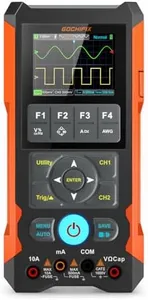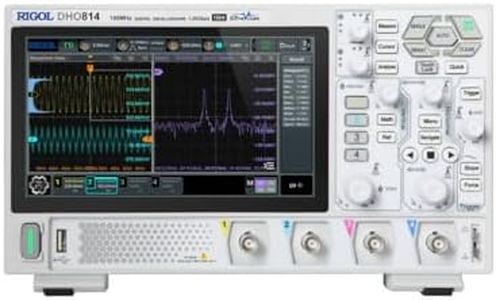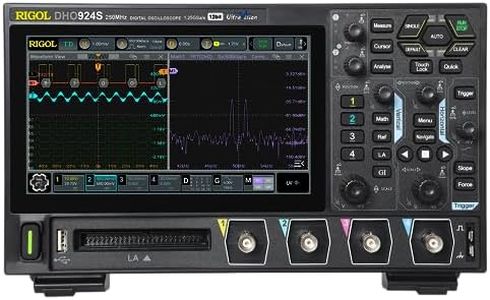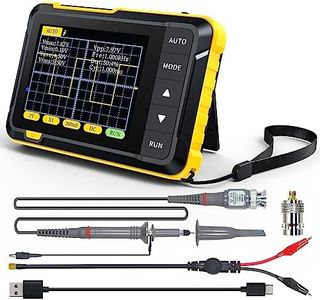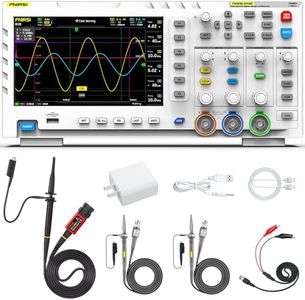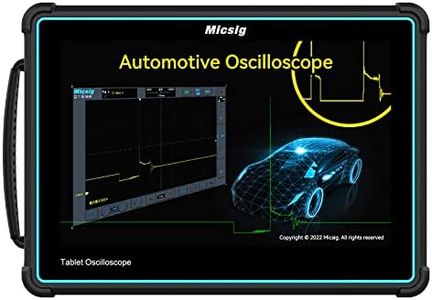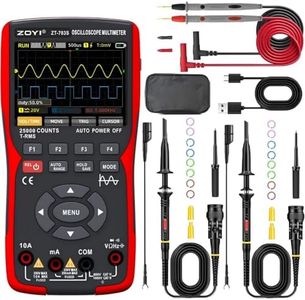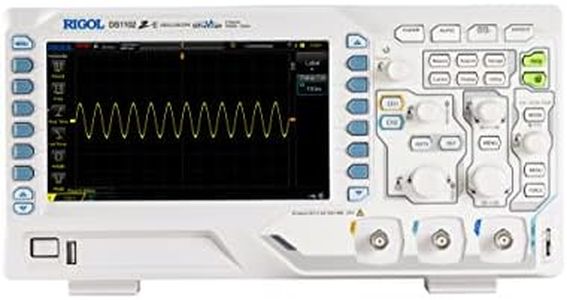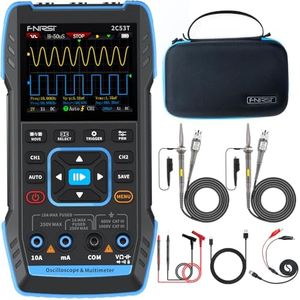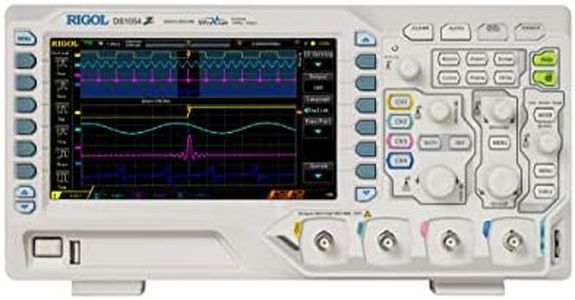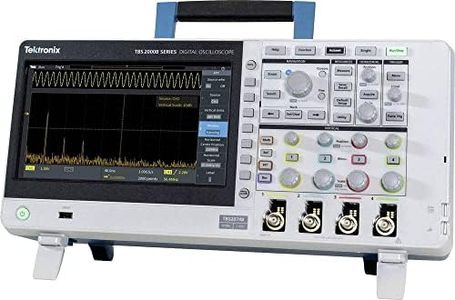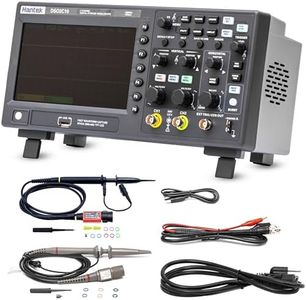10 Best Digital Oscilloscopes 2025 in the United States
Our technology thoroughly searches through the online shopping world, reviewing hundreds of sites. We then process and analyze this information, updating in real-time to bring you the latest top-rated products. This way, you always get the best and most current options available.

Our Top Picks
Winner
RIGOL Digital Oscilloscope DHO814 100MHz Frequency Band + 12-bit Vertical Resolution + Maximum 1.25 GSa/s Sample Rate + 1000,000 wfms/s Waveform Capture Rate + 4 Analog Channels + 25 Mpts Maximum Memo
Most important from
124 reviews
The RIGOL Digital Oscilloscope DHO814 is designed for professionals and hobbyists who need reliable performance in a compact package. With a bandwidth of 100 MHz and up to 1.25 GSa/s sample rate, it meets the demands of various applications, from basic electronics to more complex signal analysis. The device's 12-bit vertical resolution enhances the clarity of signals, allowing for better observation of small fluctuations that may otherwise go unnoticed.
One of its standout features is the support for up to four analog channels, enabling users to analyze multiple signals simultaneously, which is a significant advantage in complex diagnostic scenarios. The 25 Mpts memory depth allows for capturing longer signals without losing detail, making it ideal for applications requiring extensive data capture. The user-friendly 7-inch touchscreen display coupled with the innovative Flex knob improves usability significantly, making navigation through options intuitive.
However, there are some drawbacks to consider. While the 100 MHz bandwidth is sufficient for many applications, professionals working with higher frequency signals may find it limiting. Additionally, though the waveform search and navigation functions are beneficial, they may have a learning curve for beginners. There are also some competitors that offer higher specifications at a similar price point, which could be a consideration for users wanting the latest features.
Most important from
124 reviews
RIGOL Digital Oscilloscope DHO924S 250MHz Frequency Band + 12-bit Vertical Resolution + Maximum 1.25 GSa/s Sample Rate + 4 Analog Channels + 1CH Built-in Signal Generator
Most important from
67 reviews
The RIGOL Digital Oscilloscope DHO924S is a solid choice for users who need a reliable tool for electronics testing and signal analysis, particularly in educational, hobbyist, or light industrial settings. With a bandwidth of 250 MHz and a maximum sample rate of 1.25 GSa/s, it offers impressive capabilities for capturing and analyzing a range of signals. The four analog channels mean you can monitor multiple signals simultaneously, which is especially useful in complex tasks.
One of the standout strengths is the 12-bit vertical resolution, providing clear and detailed signal representation. The ultra-low background noise enhances the purity of the signals you capture, making it easier to work with small signals that might be missed with other oscilloscopes. Additionally, the scope's high-definition 7-inch touch screen enhances user experience, allowing for intuitive navigation and display of data.
However, there are some drawbacks to consider. While it’s robust in features, the learning curve might be steep for beginners unfamiliar with oscilloscope functions, despite the user-friendly Flex knob designed to simplify operation. The model also weighs around 3.9 lbs, which is relatively lightweight, but may still be cumbersome for portable use in various environments. Lastly, while it supports a variety of advanced features such as waveform navigation and digital signal analysis, users who need extensive customization or advanced analysis might find the capabilities somewhat limited compared to higher-end models.
The RIGOL DHO924S is well-suited for those needing a dependable and feature-rich digital oscilloscope without entering the high-end price range. Its combination of performance and usability makes it ideal for students, hobbyists, and professionals who require a versatile tool for electronics troubleshooting and design.
Most important from
67 reviews
RIGOL Digital Oscilloscope DHO804 70MHz Frequency Band + 12-bit Vertical Resolution + Maximum 1.25 GSa/s Sample Rate + 1000,000 wfms/s Waveform Capture Rate + 4 Analog Channels
Most important from
124 reviews
The RIGOL Digital Oscilloscope DHO804 is a versatile and feature-packed device, perfect for professionals and enthusiasts in the electronics field. It offers a 70MHz bandwidth, which is sufficient for analyzing a wide range of signals. The sample rate of 1.25 GSa/s ensures high-resolution signal capture, and with 12-bit vertical resolution, it provides more detailed and accurate measurements compared to many 8-bit oscilloscopes on the market. The four analog channels allow for multi-signal analysis, making it a handy tool for complex troubleshooting and development tasks.
The memory depth of up to 25 Mpts means you can store extensive data for in-depth analysis. The oscilloscope's ultra-low background noise and high waveform capture rate (up to 1 million wfms/s) help to detect even the smallest signal anomalies, enhancing its reliability and precision. The 7-inch HD touch screen enhances the user experience with clear visuals and intuitive controls. Connectivity options including USB, LAN, and HDMI ports offer flexibility for data transfer and external display connections.
The compact form factor and lightweight design make it portable and easy to handle. However, the 70MHz bandwidth might be limiting for users who need to analyze higher frequency signals. Additionally, while the device supports a high-definition display and interactive controls, it might have a learning curve for beginners unfamiliar with advanced oscilloscopes. The 3-year warranty provides peace of mind, ensuring durability and long-term reliability. Accessories like probes, power cable, and USB cable are included, making it ready to use out of the box. This oscilloscope is a solid choice for those looking for a mid-range option with robust features and dependable performance.
Most important from
124 reviews
Buying Guide for the Best Digital Oscilloscopes
Choosing the right digital oscilloscope can be a daunting task, especially if you're new to the field. A digital oscilloscope is an essential tool for anyone working with electronics, as it allows you to visualize electrical signals and diagnose issues in circuits. To make an informed decision, it's important to understand the key specifications and how they relate to your specific needs. Here are the main specs you should consider when selecting a digital oscilloscope.FAQ
Most Popular Categories Right Now
